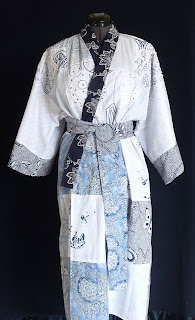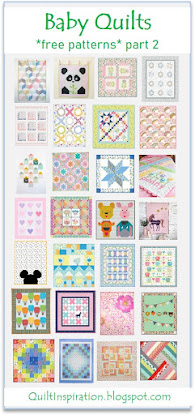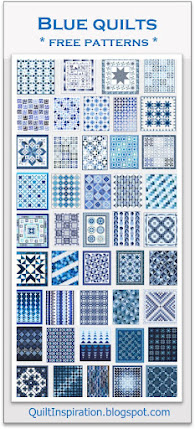Antique Orange and Blue Tumbling Blocks Quilt, circa 1880, at Material Pleasures; Double Wedding Ring Quilt, Meander Publishing Quilt Collection; High Hopes by Sally Dickinson, at the 2010 Arizona Quilters Guild Show
In school we were taught that there are three primary colors (yellow-blue-red) and three complementary pairs (yellow-violet, blue-orange, and red-green). Now we realize that there are many more hues in the spectrum. Each of the quilts shown above has a different hue of blue, from true blue to aqua, and a different complement that ranges from yellow-orange to orange-red. Color theory should make it easier to create these complementary pairs... but which tool(s) are the best ?
Color Scheme Designer: This free web tool will facilitate finding an optimal color palette based on a traditional yellow-blue-red color wheel. Go to Color Scheme Designer and click somewhere on the color wheel to pick a starting color, like Orange, then click on the "Complement" button above the wheel. You will see the color scheme shown below:
Once you have a palette, you can even view it in terms of standard Pantone colors; just click on the "color space" tab at the upper right of the screen, as shown below.
By playing around with Color Scheme Designer for just a few minutes you can learn a lot about color schemes. For example, try shifting the color wheel towards red and see how the complement shifts, and try out the triadic, analogous and accented analogous schemes!
The Ives Color Wheel, and the Ultimate 3-in-1 Color Tool
The Ultimate 3-in-1 Color Tool is based on the Ives Color Wheel, below, which is significantly different from the traditional color wheel used in Color Scheme Designer. You can take the 3-in-1 tool to the fabric store, which makes it exceptionally useful; but does the Ives color wheel really make a difference?
 |
| click to enlarge the image |
The short answer is 'yes'. Joen Wolfrom explains*: "Most of us learned that the primary colors are yellow, red and blue. A color wheel using these three primary colors results in blends not nearly as beautiful or dynamic as the yellow-magenta-turquoise combination used in the Ives Color wheel." Also: "If you used the 24-step color wheel we grew up with, with red, yellow and blue for your complements, you're two steps off. That doesn't make an ugly quilt, but you could use the right color wheel and it would be stunning rather than okay."
Since "stunning" is what we're aiming for, we did an experiment: we started with a tint of aqua blue (slightly lighter than pure aqua blue) which is at about -8- on the Ives wheel. Its complement, which is directly opposite on the wheel, is orange-red (-20-) (below, left).
In contrast, Color Scheme Designer - which is based on a traditional color wheel - predicted an orange-yellow complement (above, right). As Joen says, the two schemes are at least two steps off. Which one do you prefer? (Leave us a comment). Now look again at the quilts at the top of the post: they all have complementary color schemes that match the Ives wheel, and the fish quilt uses a stunning aqua blue and orange-red color scheme that is similar to the one in our experiment. Since the Ultimate 3-in-1 Color Tool now includes HEX, CMYK and RGB formulas, you can cross-reference the Ives hues with all other sites and programs. Now that's cool (er, hot).
Finally, here is a fascinating story about the history of the traditional color wheel, direct from Joen Wolfrom:
"While I was doing research for my upcoming book, Adventures in Design, I found some answers to questions that I have wondered about for a long time. I have always wanted to know where or how the yellow, red, and blue color wheel originated. Here’s what I found in my recent investigation:
The historic color wheel (primaries of yellow, red, and blue) was devised by a small group of artists more than a century ago who felt the need to organize their pigment colors in an understandable fashion to help them with color selection. They placed blobs of color around a circle showing their available pigments. It became popular to make one’s own informal color circle to help organized color, using the various pigments on hand. Eventually a printing house printed a circle of color for artists that offered a logical, easy color reference based on this idea. Hence, this color wheel has been our reference for decades.
Not surprisingly, modern technology has led to new discoveries in color study. The physics of color is a vast field and we should be taking advantage of much of the information that is now available to us, due to color research. Admittedly, it is sometimes hard to say goodbye to old habits. Most of us no longer read by lantern nor cook from a wood stove, although these were the acceptable modes of attaining light and heat when the first color wheel was created. Nature hasn’t changed its way of coloring the world, but with the modern equipment available to us, the way we use color in our homes, our art, and our business can be so much more effective if we use the knowledge of today rather than the rather informal assumptions of yesteryear."
Stay tuned, because we have more cool tools, hot tips and insights to share with you in upcoming posts!
*More links: You can read about the Ives color wheel - and successful color schemes - in ColorPlay



















Wow! As usual, great quilts and great information. I have never heard of the Ives color wheel. I prefer the Ives color scheme as the orange red is deeper and richer than the traditional orange used. I'll have to look into the Ives wheel more closely. Thanks!
ReplyDeleteThank you! There's so much to learn each and every time I visit your blog. Our old monitor has some color issues, but my preference based on what I see is the Ives color scheme, though my favorite batik at the moment features an aqua somewhat lighter than this teamed up with a yellow-orange. Will have to check that out based on the various color wheels to see which it more closely follows. Thanks again for our daily inspiration.
ReplyDeleteThank you so much for your feedback and comments about the post ! Originally we were going to feature a lovely raffle quilt that was aqua blue with yellow-orange. Then when we looked at the Ives complementary pair we realized it was much better, so we ditched the raffle quilt. The subject is so fascinating, and we are having so much fun exploring it (there's more to come). We really appreciate your thoughtful comments on this post !
ReplyDelete